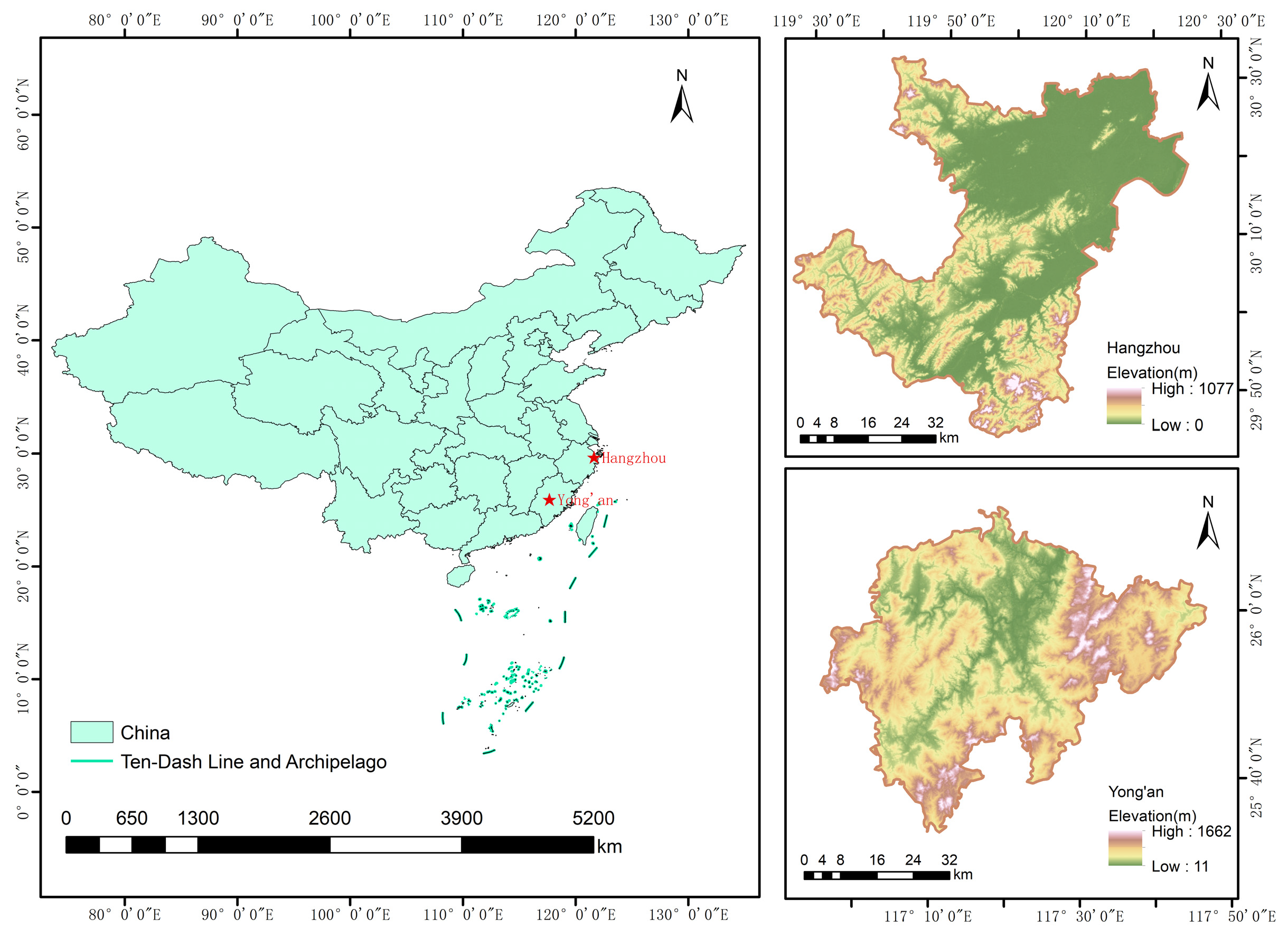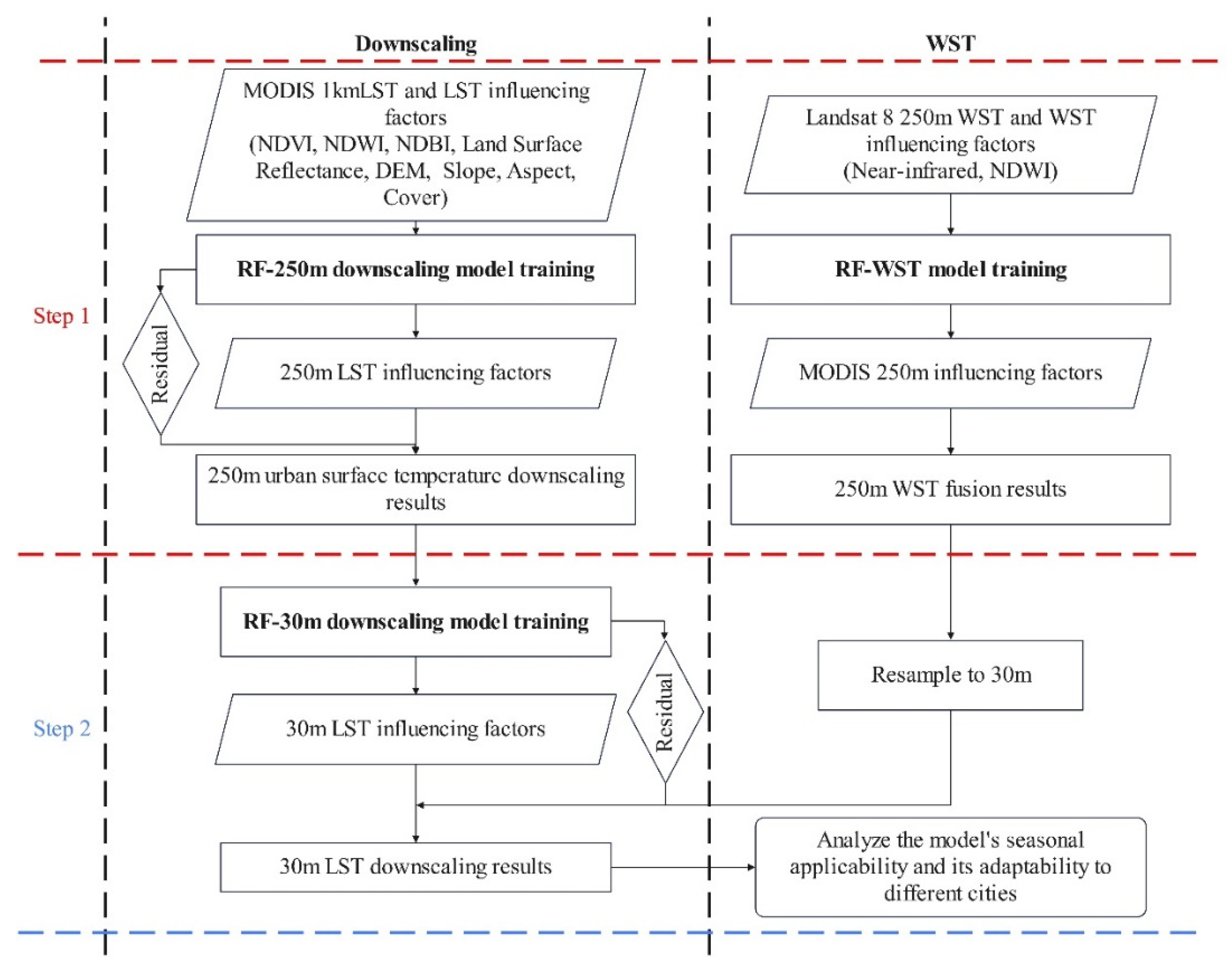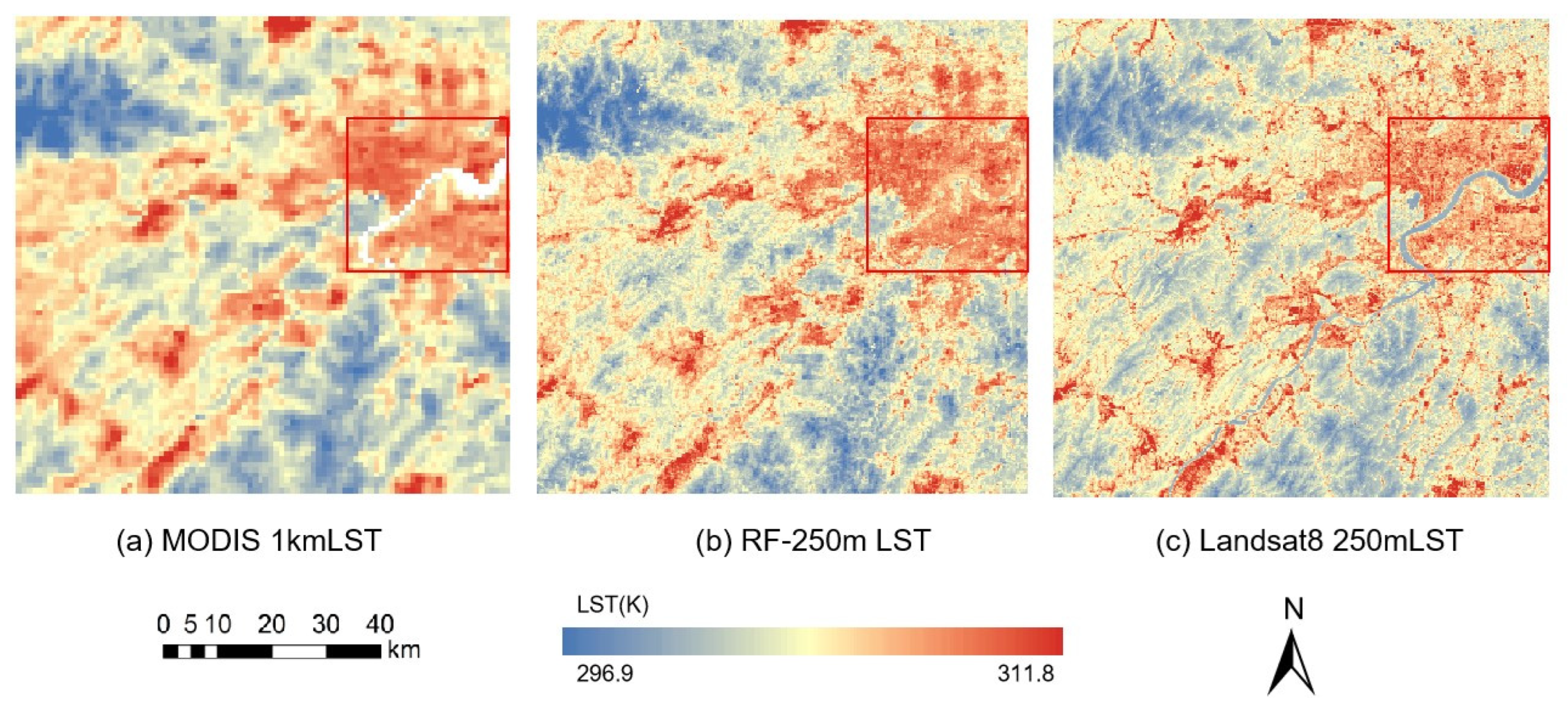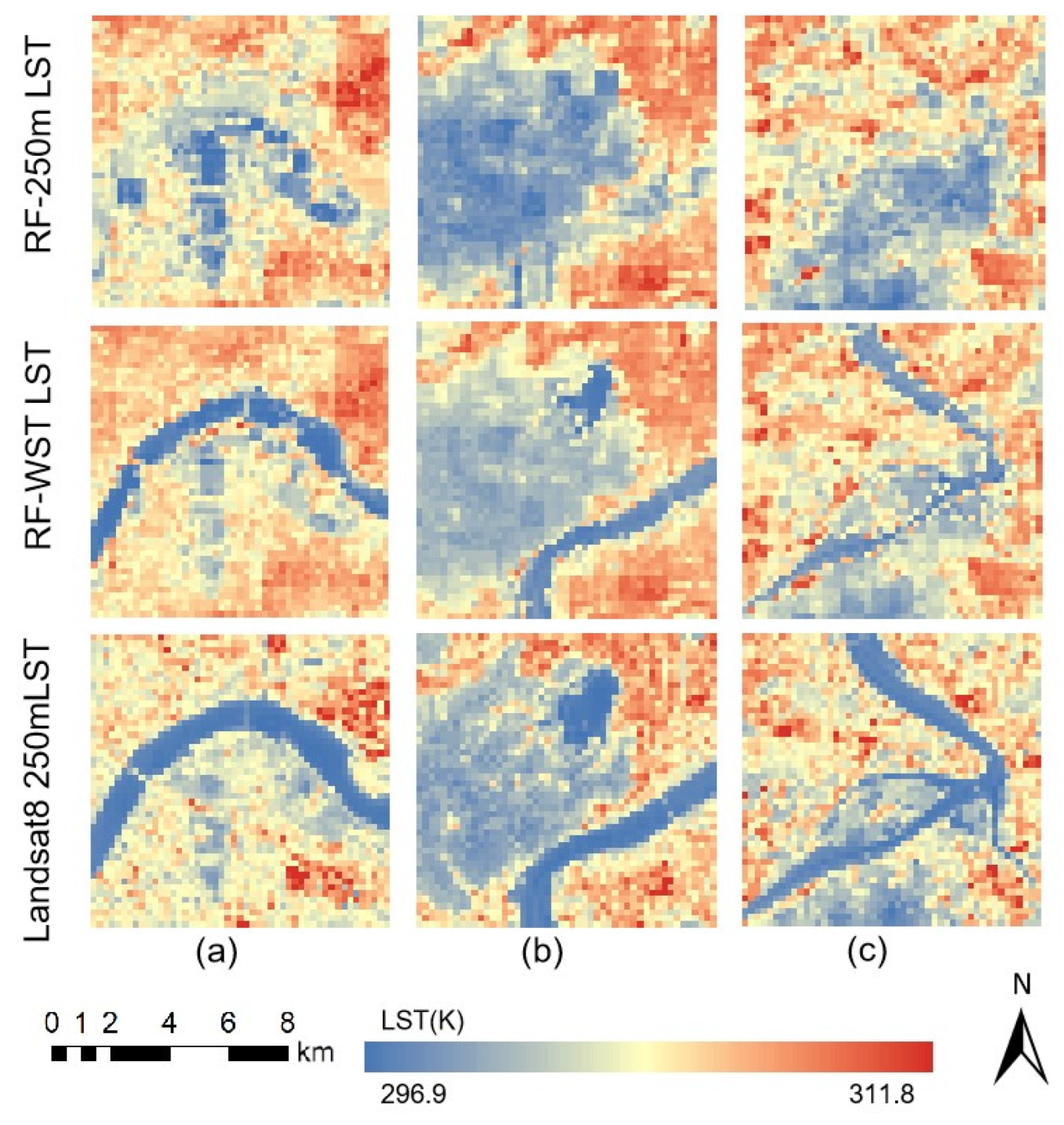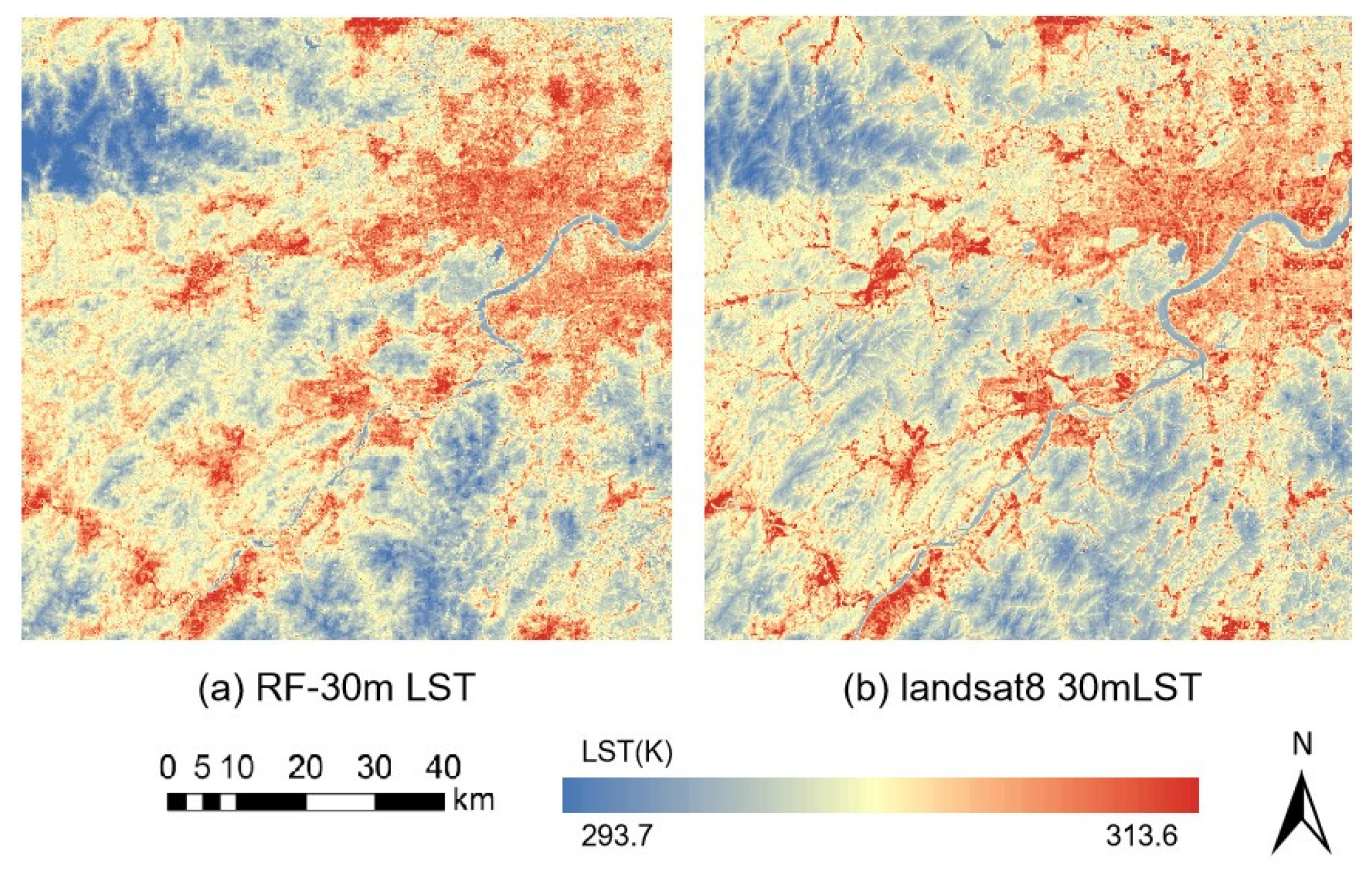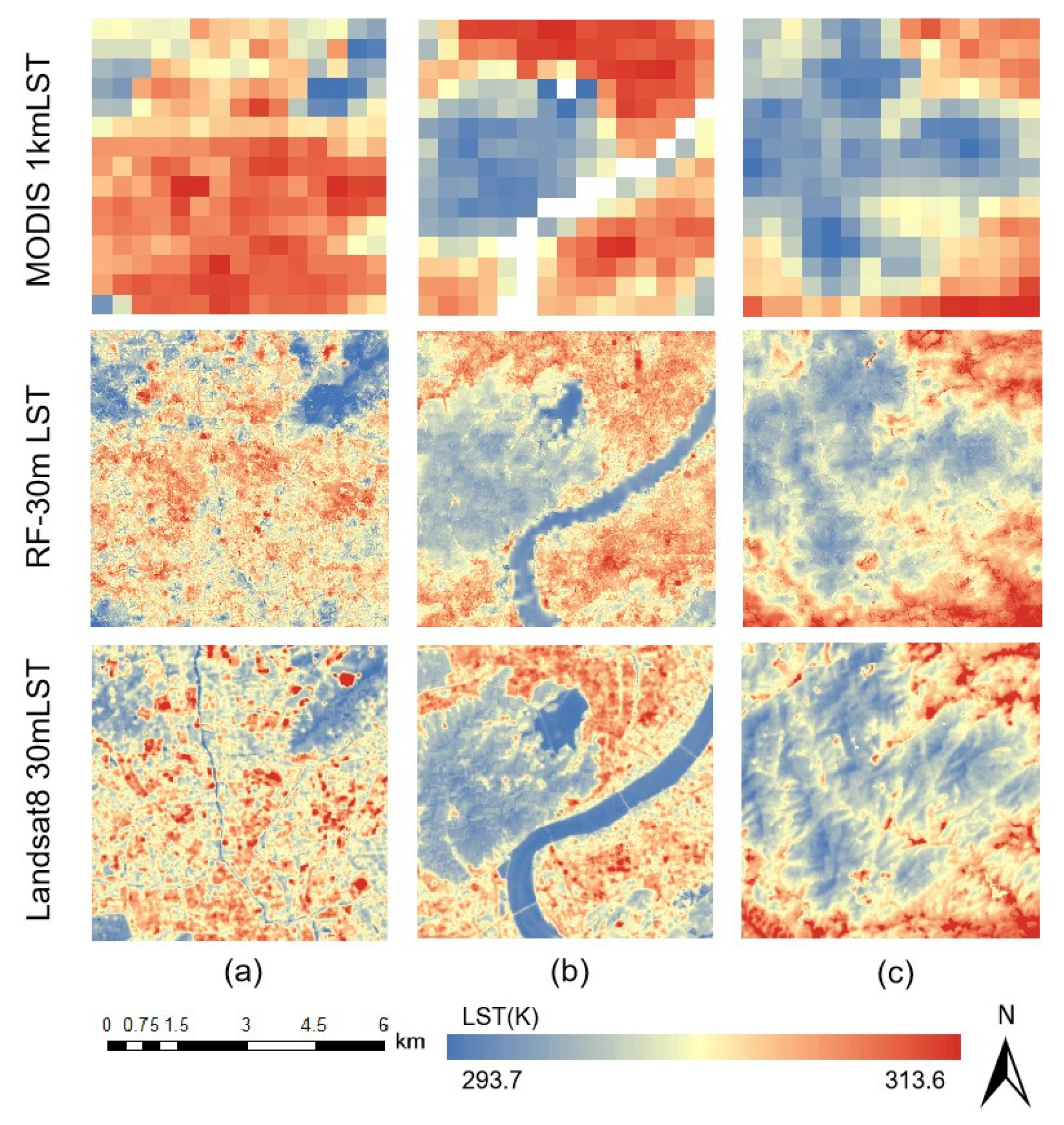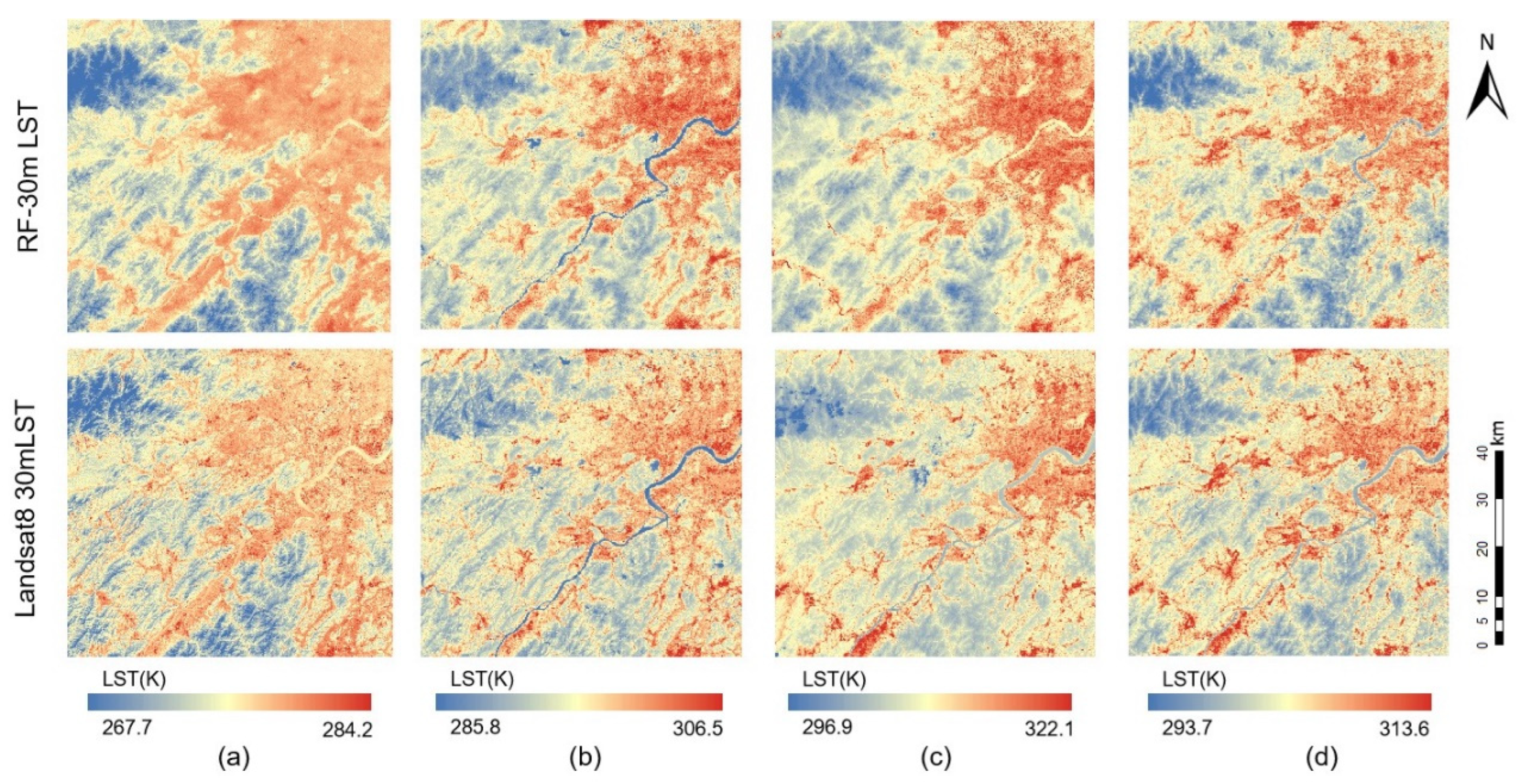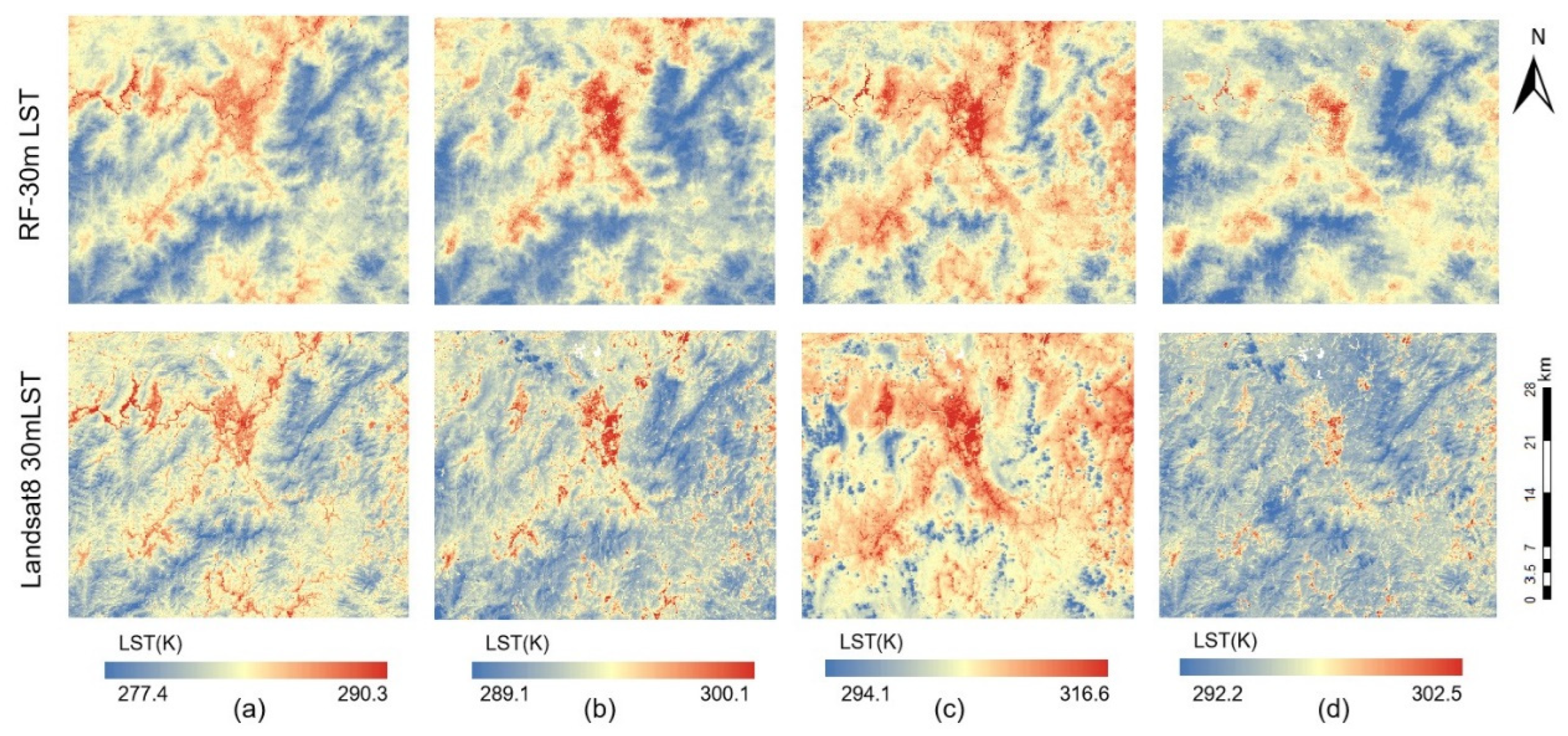3.2. Water Surface Temperature Fitting Model Results and Analysis
In
Figure 4, it can be observed that the MODIS-retrieved LST exhibits gaps in water surface areas (indicated by the red box). In this study, the constructed RF-WST model was utilized to fit the surface temperature for the water body regions. The fitting results are presented in
Figure 5.
In is evident in
Figure 5a that there is a notable issue where the water surface temperatures cannot be distinctly differentiated from the surface temperatures of the surrounding land areas. This lack of clear distinction complicates the accurate representation of thermal dynamics in water bodies.
In contrast, after applying the RF-WST model to the 250 m LST results in
Figure 5b, a more pronounced separation between the water surface temperatures and the underlying LST can be observed. The optimization provided by the RF-WST model effectively enhances the accuracy of the water temperature estimates, allowing for a clearer understanding of the spatial variations in temperature around aquatic environments.
In
Table 4, it can be observed that after applying the RF-WST model, the R value for the LST prediction results improved by 0.0061, while the RMSE decreased by 0.0168 K. This indicates that the RF-WST model effectively optimized the downscaled 250 m LST results to a certain extent, successfully addressing the issue of missing water body temperature retrievals in the MODIS data.
To further validate the enhancement in the water body regions, three different water body areas that previously showed voids in the MODIS LST data were selected for comparison.
In
Figure 6, it is evident that after the optimization of water surface temperatures using the RF-WST model, the LST in water body areas contains more detailed information than the LST obtained from the RF-250 m model. Additionally, there is a clear distinction between the temperatures of the water bodies and the surrounding LST. This observation demonstrates that the RF-WST model exhibits good stability and reliability in accurately capturing water surface temperatures.
In
Table 5, the Landsat 8-retrieved LST serves as the true value to evaluate the R and the RMSE for the RF-250 m, RF-WST, and Landsat 8 results. The improvements in correlation coefficients for regions a, b, and c were 0.2971, 0.0702, and 0.0811, respectively, while the RMSE decreased by 0.2016 K, 0.0569 K, and 0.0678 K for the same regions.
Region a features a larger water surface area with a clear boundary from the surrounding land, resulting in the most pronounced improvement in fitting performance with the RF-WST model.
Region b, which encompasses both lakes and rivers, demonstrated that the RF-WST model effectively captured the surface temperatures of these water bodies, highlighting its reliability in various aquatic contexts.
Region c exhibited poorer model fitting performance, which was likely due to the narrow configuration of the water bodies combined with the 250 m spatial resolution of the imagery, which impacted the accuracy of the model simulations.
3.3. Results of 30 m Downscaling and Analysis
Based on the selected influencing factors—DEM, ASPECT, SLOPE, and COVER—the optimal model parameters were input to construct the second-step downscaling model, RF-30 m. The coarse-resolution LST data in the RF-30 m model were derived from the LST outputs of the RF-WST model. The RF-30 m model calculates the fitted LST values, which are then used to compute the residuals in comparison with the outputs from RF-WST. With the 30 m resolution influencing factors, fitted LST values at 30 m are obtained, and these are combined with the residuals, resulting in the final downscaled 30 m LST estimates.
In
Figure 7, it is evident that after the downscaling with the RF-30 m model, the overall spatial distribution of LST shows a high degree of consistency with that of Landsat 8. When compared with the 30 m LST from Landsat 8, the R value was found to be 0.8142, and the RMSE was 3.4172 K. These results fall within an acceptable error range, demonstrating that the RF-30 m model exhibits good accuracy.
To further assess the effectiveness of the downscaling results, this study conducted comparisons across three distinct regions, urban, water, and vegetation, as depicted in
Figure 8a–c.
Analysis of
Figure 7 indicates that in the urban area (a), the RF-30 m model markedly enhances the detail of the LST; however, it does exhibit a tendency to overestimate surface temperatures within this region. In the water body area (b), the RF-30 m model effectively distinguishes the water surfaces from surrounding land areas, successfully addressing the voids in MODIS LST data. Nonetheless, some jagged artifacts are observable along the water boundaries. For the vegetation area (c), the overall distribution of surface temperatures is consistent with the validation data, yet the model does not adequately capture effects such as shading caused by mountainous terrain.
According to the data presented in
Table 6, the R value for the urban and water regions are 0.6795 and 0.7880, respectively, with corresponding RMSE values of 4.7980 K and 4.1951 K. In contrast, the vegetation region demonstrates a superior correlation coefficient of 0.8606 and a significantly lower RMSE of 1.5694 K, indicating that the downscaling performance is notably more effective in the vegetation area than in the urban and water regions.
3.4. Analysis of the Applicability of the Downscaling Model
To further validate the applicability of the downscaling model across the four seasons, this study selected key dates, 28 January 2023, 2 April 2023, and 29 July 2023, representing winter, spring, and summer, respectively. These dates were analyzed alongside the data from 6 September 2022, to assess the model’s seasonal effectiveness in Hangzhou.
The validation data for January and April were obtained from Landsat 8 imagery captured on the same dates. However, due to data availability issues, the validation data for 29 July 2023, were sourced from the preceding day’s Landsat 8 imagery from 28 July 2023.
Figure 9 presents a comparative analysis of the downscaling model’s application in Hangzhou across the four seasons.
Table 7 provides the accuracy validation results for the different seasons. Overall, the downscaled LST exhibits a high degree of consistency in spatial distribution when compared with the Landsat LST data, meeting this study’s requirements.
In the seasonal analysis, it is observed that the model performs best in spring, where the spatial distribution of LST closely aligns with that of the Landsat data, as indicated by the high R and a low RMSE. In both autumn and winter, the model yields good downscaled results; however, there is a tendency to overestimate temperatures in urban areas. Conversely, in summer, the RMSE significantly increases, reflecting a poorer downscaling performance.
Considering the regional variability in the downscaling model’s performance, this study additionally selected seasonal data from Yong’an, Fujian Province, to compare the downscaling results. The seasonal data included the following dates: 18 December 2022, 9 April 2023, 11 July 2023, and 3 November 2023, representing winter, spring, summer, and autumn, respectively, for Yong’an. The 30-meter downscaling results for Yong’an across different seasons are presented in
Figure 10.
In the figures, it is evident that the downscaled results for the winter and spring seasons show substantial agreement with the validation data in terms of the spatial distribution. However, during the summer, there is an observed overestimation of water body temperatures. In the autumn season, a general overestimation of temperatures in urban areas is noted, which aligns with the findings from the downscaled results for Hangzhou.
As indicated in
Table 8, during the winter and spring seasons, the downscaled results exhibit high R and low RMSE values. Conversely, an increase in the RMSE is also observed during the summer months, which is similar to the trends noted previously. In the autumn season, the correlation coefficient is relatively low, indicating poorer model performance in capturing surface temperature dynamics during that period.
Considering the differences between the MODIS and Landsat sensors, discrepancies exist between the two LST results [
26,
27]. Therefore, the Landsat surface temperature data were resampled to a 1 km scale for comparison with the MODIS data. This allowed for an analysis of the systematic errors between the two datasets and an evaluation of the feasibility of the downscaled results.
Table 9 presents the comparative results between Landsat 8 and MODIS data at 1 km spatial resolution for Hangzhou and Yong’an.
(1) In Hangzhou, for the winter, spring, and autumn seasons, the downscaled RF-30 m LST shows an improvement in correlation (R) compared with the original MODIS data, with the RMSE values showing a modest increase, remaining below 0.2 K and, thus, within an acceptable error range. However, during the summer, the downscaled RF-30 m LST exhibits a reduction in R by 0.0134, while the RMSE increases by more than 0.2 K, which is inconsistent with the patterns observed in the other three seasons.
(2) In Yong’an, for the winter, spring, and autumn seasons, the downscaled RF-30 m LST shows an increase in correlation (R) compared with the original MODIS data, and the RMSE values decline. However, in the summer, the downscaled RF-30 m LST shows a decrease in R of 0.0213, along with an increase in RMSE of 0.0583 K.
(3) Combining the results from Hangzhou and Yong’an, it is evident that the downscaling model performs better in winter, spring, and autumn, while its performance is poorer in summer. The downscaled LST in the winter, spring, and autumn seasons shows improved correlation, with the RMSE also remaining within acceptable limits.
Based on the previous literature [
28,
29], it can be inferred that during the summer, the Landsat 8 imaging time used for validation is approximately half an hour later than that of MODIS. Given the higher temperatures in summer and the rapid warming of surface temperatures, the final LST data obtained from Landsat 8 are likely to be higher than the MODIS LST products. This discrepancy could contribute to the larger RMSE between the two datasets.
Moreover, in the downscaled RF-30 m LST results for the summer, some water body areas exhibit an overestimation of LST. This may be attributed to the fact that the RF-WST model was constructed using Landsat 8 LST data as the training dataset, which could lead to biased fitting results, resulting in the overestimation of water surface temperatures.
To better analyze the high-error phenomenon in the summer downscaling results, this study additionally selected data from Wuhan on 21 July 2024, and Beijing on 19 July 2023, for downscaling. These results were then compared with the summer downscaling results of Hangzhou and Yong’an from this study.
Table 10 presents the validation results by comparing the summer downscaling outcomes of the four cities with the Landsat 8 data.
As shown in the table, the downscaling results for multiple summer time series across the four cities exhibit relatively high RMSE values when compared with the Landsat 8 data. This indicates certain limitations in the model’s performance during the summer downscaling process. Notably, Beijing and Wuhan have more complex underlying surface distributions and a wider spread of impervious surfaces compared with the other cities, which impacts the model’s fitting accuracy.
